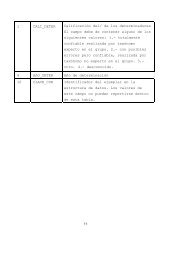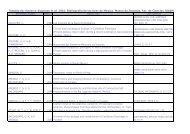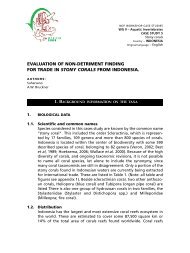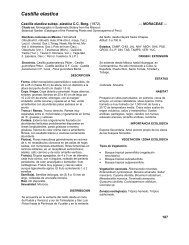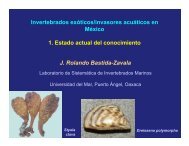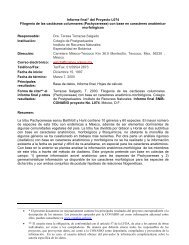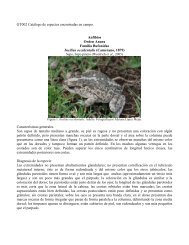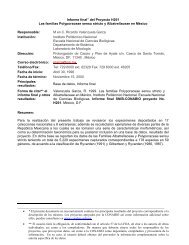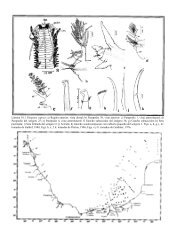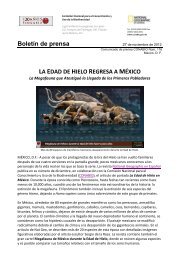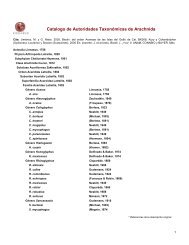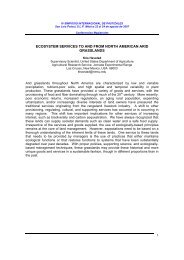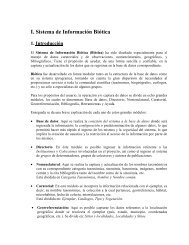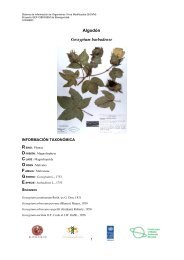Informe final* del Proyecto B002 Inventario de la ... - Conabio
Informe final* del Proyecto B002 Inventario de la ... - Conabio
Informe final* del Proyecto B002 Inventario de la ... - Conabio
You also want an ePaper? Increase the reach of your titles
YUMPU automatically turns print PDFs into web optimized ePapers that Google loves.
INFORME FINAL DE LAS SALIDAS A LA REGION DE LOS CHIMALAPAS, OAXACA.<br />
FECHA: FEBRERO - OCTUBRE DE 1995.<br />
LOCALIDADES: SAN ISIDRO LA GRINGA Y CHALCHIJAPA.<br />
GRUPO: HERPETOLOGIA.<br />
EDMUNDO PEREZ RAMOS<br />
LUIS CANSECO MARQUEZ.<br />
Con el presente informe damos un resumen final <strong>de</strong> <strong>la</strong>s activida<strong>de</strong>s llevadas a cabo<br />
<strong><strong>de</strong>l</strong> proyecto "<strong>Inventario</strong> <strong>de</strong> <strong>la</strong> Biodiversidad <strong>de</strong> vertebrados terrestres <strong>de</strong> los Chima<strong>la</strong>pas,<br />
Oaxaca", en el cual <strong>de</strong>stacamos el hábitat, el intervalo altitudinal y regiones fisiográficas,<br />
don<strong>de</strong> fueron capturados los anfibios y reptiles <strong>de</strong> <strong>la</strong> región <strong>de</strong> los Chima<strong>la</strong>pas.<br />
Las localida<strong>de</strong>s visitadas fueron San Isidro La Gringa y Chalchijapa durante cuatro<br />
ocasiones cada una en el transcurso <strong>de</strong> ocho meses, apartir <strong><strong>de</strong>l</strong> 17 <strong>de</strong> febrero al 28 <strong>de</strong><br />
octubre <strong><strong>de</strong>l</strong> año en curso próximo pasado; allí se registraron un total <strong>de</strong> 73 especies y<br />
subespecies correspondientes a 22 <strong>de</strong> anfibios y 51 <strong>de</strong> reptiles (APENDICE 1). Ambas<br />
localida<strong>de</strong>s presentan zonas <strong>de</strong> vegetación primaria <strong>de</strong> Bosque Tropical Perennifolio y<br />
áreas perturbadas (acahuales, cultivos y potreros), a<strong>de</strong>más <strong>de</strong> vegetación <strong>de</strong> lugares<br />
inundables.<br />
En general, el intervalo altitudinal que se muestreó varió <strong>de</strong> 76-980 m en <strong>la</strong> primera<br />
localidad y <strong>de</strong> 210-975 m para <strong>la</strong> siguiente; presentándose áreas <strong>de</strong> montañas bajas y<br />
algunas partes p<strong>la</strong>nas. En <strong>la</strong>s dos localida<strong>de</strong>s existen cuencas <strong>de</strong> ríos permanentes <strong>de</strong><br />
corriente rápida, arroyos intermitentes o <strong>de</strong> fuertes crecidas y algunas zonas inundables.<br />
En el Apéndice 2 se muestran <strong>la</strong>s especies que se encuentran en alguna categoría<br />
<strong>de</strong> <strong>la</strong> norma oficial mexicana <strong>de</strong> SEDESOL y en los apéndices <strong><strong>de</strong>l</strong> SITES; se hace incapié<br />
que ninguna <strong>de</strong> <strong>la</strong>s especies <strong>de</strong> anfibios y reptiles <strong>de</strong> <strong>la</strong> región <strong>de</strong> los Chima<strong>la</strong>pas están<br />
incluidas, hasta el momento, en <strong>la</strong> lista internacional <strong>de</strong> <strong>la</strong> IUCN.



